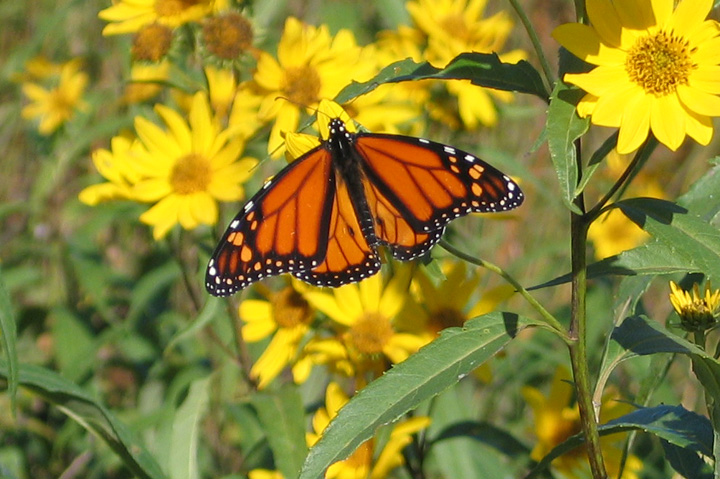
Monarch Butterfly Migration Over Central
Iowa
Fall 2011
By Robert D. Woodward

The fall migration of monarch butterflies has begun over central Iowa, and once again the movement is being monitored at Neal Smith National Wildlife Refuge near Prairie City, Iowa, and in our butterfly garden in Altoona, Iowa.
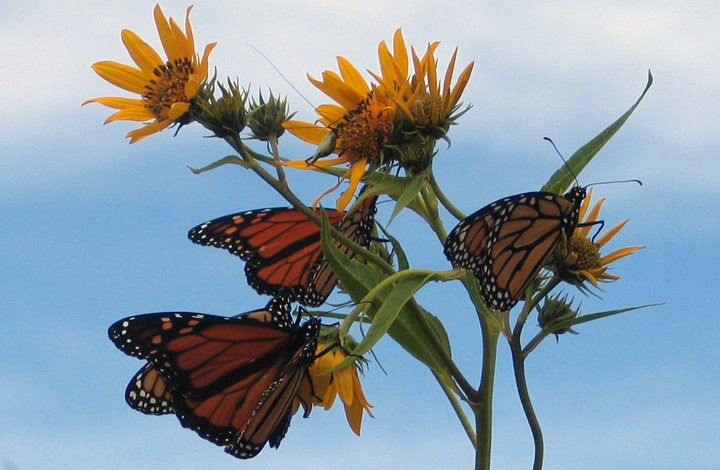
Monarchs Hold On Against Strong Wind September 14
September 2--During a half-hour visit to Neal Smith Refuge, we saw only one monarch. A check of reports in previous years will indicate variations in the first significant arrivals at Neal Smith, but the first week of September normally will lead to some heavy migration days. Cooler overnight weather expected in Minnesota and Iowa in the days ahead suggests the movement of monarchs to the south may pick up considerably across central Iowa.
September 3--Rainy day. No butterfly activity.
September 4--During one hour of observation at Neal Smith Refuge, no monarchs were noted.
September 5--The first significant monarch migratory movement of the fall was seen at Neal Smith National Wildlife Refuge during a two-hour visit in the morning. Sixty-three monarchs were spotted flying over the prairie and nectaring on the wildflowers there. In a pattern that has occurred during past years for this time of the year, the monarchs were favoring tickseed sunflowers for their nectaring. The temperature was in the mid-50s, and cooler mornings were being reported to the north in Iowa and Minnesota--an indicator the monarchs likely would be moving south.
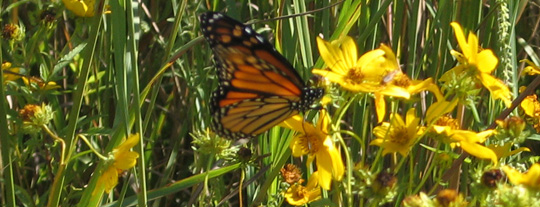
A Monarch Visits the Tickseed Sunflowers
September 6--Monarch butterfly migration activity appeared to be growing at Neal Smith National Wildlife Refuge. The day was clear in the high 50s with a slight breeze. During two hours in the late morning, 290 monarchs were observed nectaring on tickseed and sawtooth sunflowers. The activity clearly was stronger than it had been a day earlier.
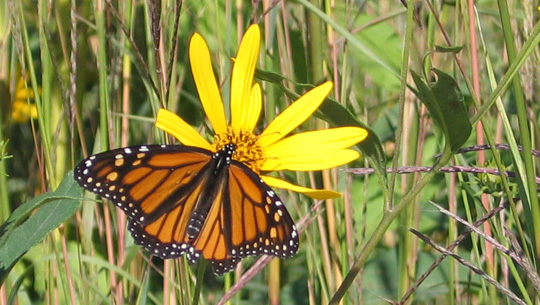
A Monarch Visits a Sunflower on a Sunny Day
September 7--The strong monarch activity continued on the prairie at Neal Smith National Wildlife Refuge. Once again, the day was beautiful with a clear morning in the mid 60s and a light wind from the east. Monarchs were seen nectaring on tickseeds, sawtooth sunflowers, and thistles. The numbers of migrating monarchs continued to increase. In two hours of observation in the late morning, 440 monarchs were noted.

Monarchs Enjoy Nectaring on the Thistles
September 8--The excellent weather continued today with a clear sky and temperatures in the mid-50s during the late morning. The wind was blowing from the north at 10 to 20 miles an hour. Monarch migrating activity continued at Neal Smith National Wildlife Refuge, but the numbers were down a bit from the previous day. Observations for two and one-half hours turned up 202 monarchs. Away from the refuge along the roadways and in our butterfly garden, other monarchs were noted moving to the south.
September 9--Not as many monarchs were observed today in areas of Neal Smith National Wildlife Refuge where their numbers had been greater earlier in the week. In one hour and 45 minutes, 104 monarchs were counted.
September 10--The day was partly cloudy with a temperature in the mid-50s in the late morning. The wind was blowing from the north at 10 miles an hour. During two hours of observation, 46 migrating monarchs were noted.
September 11--On this memorial of the 10th anniversary of the 9/11 disaster, Neal Smith National Wildlife Refuge was a beautiful setting for the day. The sun was shining brightly in the morning, the temperature was in the mid-50s, and a breeze was blowing from the north at 10 miles an hour. During a one-hour visit in the morning, 71 migrating monarchs were counted. A return visit in the late afternoon turned up another 145 monarchs in an hour and 15 minutes.
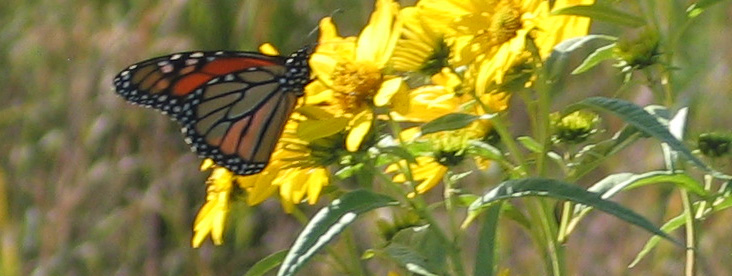
September 12--Monarch activity was continuing at Neal Smith National Wildlife Refuge. The day was sunny, the temperature was in the high 60s, and the wind was blowing from the south southwest at 20 miles an hour. During a visit of one hour and 15 minutes, 140 monarchs were counted nectaring primarily on sawtooth sunflowers blowing in the wind.
September 13--Two monarchs visited our garden in Altoona in mid-afternoon after limited sightings there in the past two days. During a visit to Neal Smith National Wildlife Refuge in the late morning, 200 monarchs were observed in two hours. The day was sunny, the temperature was in the high 50s, and the wind was blowing from the north at 10 miles an hour. At the refuge, sawtooth sunflowers were the center of the nectaring by the monarchs. In our butterfly garden, the goldenrod seemed to be the main attraction.
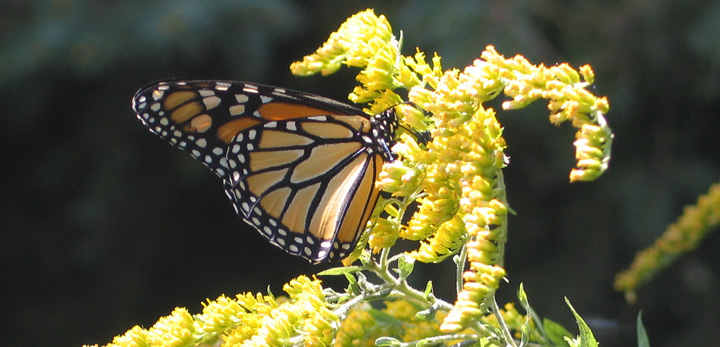
September 14--A light rain, strong wind, and temperature in the low 50s at the Neal Smith National Wildlife Refuge slowed monarch butterfly activity in mid-morning, but as the rain quit and the sky cleared, monarchs were found holding on to tall sunflowers waving in that wind. Groups of four to six monarchs were hanging together on the flowers. In two hours, 39 monarchs were counted. A second visit to the refuge in the afternoon turned up another 22 monarchs in one hour. The day clearly demonstrated the difficulties monarchs must face as they seek to make their way south to the Mexico wintering grounds.
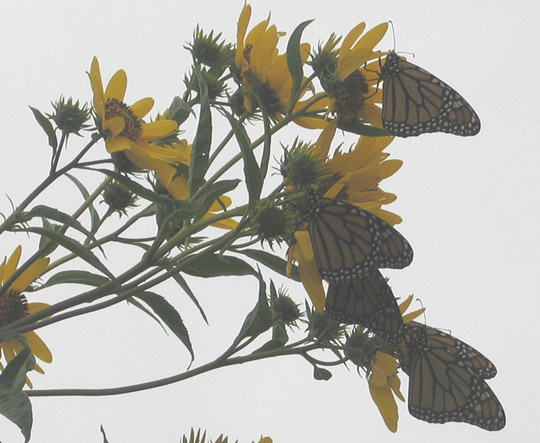
Monarchs Fight A Strong Wind by Holding On
September 15--Cold overnight temperatures in the 30s and low 40s in northern Iowa and Minnesota kept the monarchs out of sight for the most part as the new day began. During a one and one-half visit to Neal Smith National Wildlife Refuge in mid-morning, only 8 monarchs were observed. Six of them were near oak trees in the prairie's savanna area. The day was partly cloudy, the temperature was in the high 40s, and a north wind was blowing at 10 miles an hour.
September 16--Two visits during the day to Neal Smith National Wildlife Refuge verified the lack of monarch butterfly activity due to weather conditions. During one hour in mid-morning, two monarchs were observed--one clinging to a tall sawtooth sunflower waving in the wind and the other flying up into the wind from the prairie grasses. In a return visit of 45 minutes in the late afternoon, no monarchs were seen. The weather was damp and chilly, and a light rain fell several times during the day.
September 17--Weather conditions continued to hamper the movement of monarch butterflies. The day was mostly cloudy and damp with a temperature in the low 50s. The wind was blowing from the east southeast at 10-plus miles an hour. In one hour and one-half of observation, 14 monarchs were noted; mostly they were coming out of protected areas for nectaring on tall sunflowers. There were no indicators of whether or not more monarchs were in the prairie grasses waiting for a better environment.
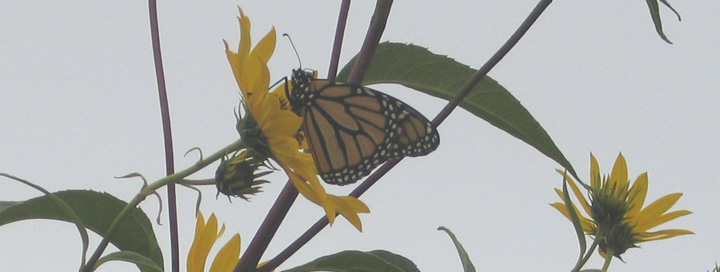
One of the Few Observed on September 17
September 18--Rainy in early morning, cloudy. Headed for Sioux Falls, South Dakota. No monarchs were seen along the way.
September 19--A monarch was seen flying over a roadway intersection in the eastern part of Sioux Falls. Very surprising given the fact that cold weather earlier had hit the area for several days.
September 20--Eight monarchs were observed flying across roadways in west and central Iowa. For several days earlier, little monarch movement had been observed. On return to our butterfly garden, two monarchs were found nectaring on purple and pink asters in the late afternoon sun.
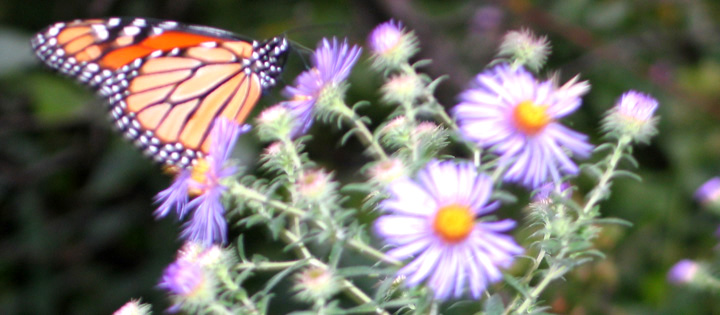
Monarch Finds A Favorite Flower--The Purple Aster
September 21--The day was clear and cool with a strong wind of 15 to 25 miles an hour at Neal Smith National Wildlife Refuge. Monarch butterflies were fighting the wind and seeking to nectar on the sawtooth sunflowers. In an hour of observation, 17 monarchs were noted.
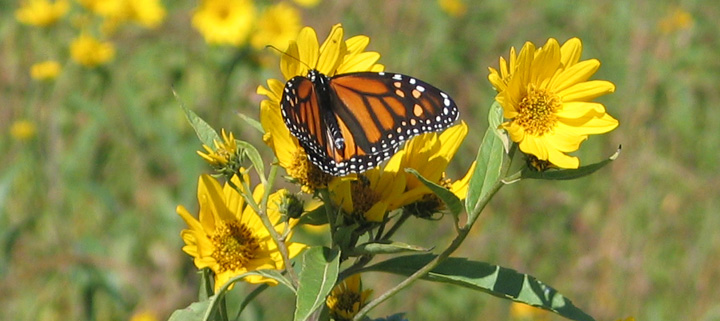
Monarch Seeks Out A Sunflower for Nectaring
September 22--Monarch butterflies showed up on a cool morning and could be seen opening their wings wide on flower after flower as they sought to warm up. In two hours of observation at Neal Smith National Wildlife Refuge, a surprising 85 monarchs were counted. The day was in the low 50s and partly cloudy with a mild wind. As the sun broke through from time to time, the bright orange wings of the monarchs could be easily spotted in a sea of yellow sunflowers.
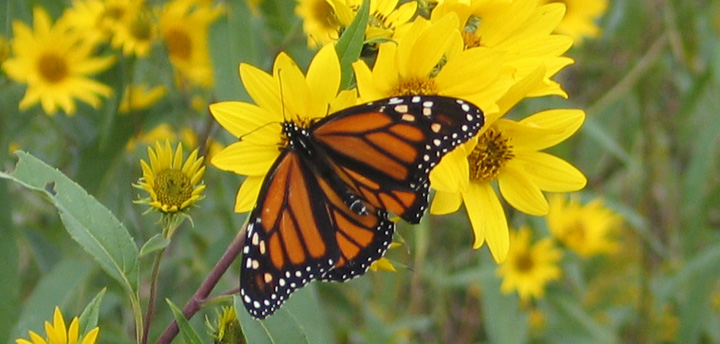
Monarch Prepares for the Long Flight South
September 23--The day was beautiful. The sky was clear, the temperature was in the low 50s, and a mild breeze was blowing. During one hour of observation at Neal Smith National Wildlife Refuge, 17 monarchs were observed in the same area as the previous day--a field of sunflowers west of a hillside full of oak trees near the savanna trail.
September 24--Monarch butterfly activity continued at Neal Smith National Wildlife Refuge. For the first time in several days, four monarchs were counted in the northern part of the refuge in areas where the butterflies had been seen in large numbers in previous years. This year, the northern sector seemed to have been bypassed for the most part by the migrating monarchs. In one hour of observation today, 12 monarchs were counted.
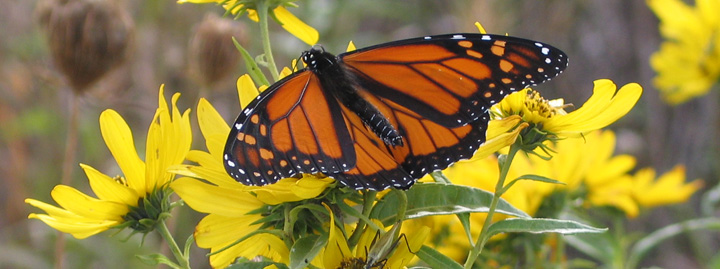
A Lonely Monarch Feeds on Sunflowers in the Northern Sector
September 25--The monarch numbers appeared to be dwindling at Neal Smith National Wildlife Refuge. Three monarchs were noted in one hour and one-half of observation in mid-morning. The day was cool with a temperature in the high 40s and partly cloudy skies.
September 26--Only a single monarch was observed during a 45-minute morning visit to Neal Smith National Wildlife Refuge. The day was mostly cloudy with a temperature in the low 50s.
September 27--For the third successive day, the number of monarch butterflies was limited. In one hour of observation at Neal Smith National Wildlife Refuge during the morning, 10 monarchs were counted. The day was partly cloudy with a temperature in the high 50s and a light breeze from the northwest.
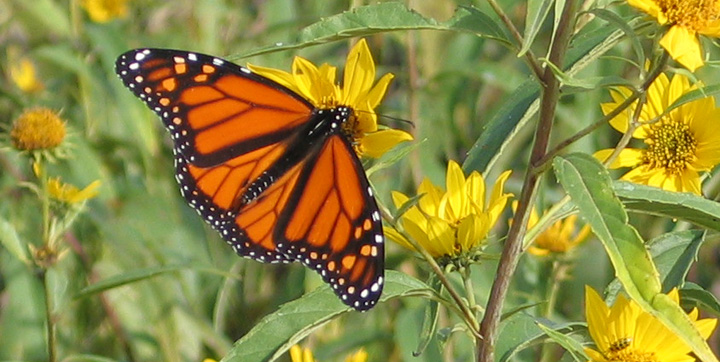
One of the Few Monarch Visitors on September 27
September 28--During a 45-minute visit to Neal Smith National Wildlife Refuge in the late morning, two monarchs were observed. The sky was partly cloudy, the temperature was in the high 60, and a light wind was blowing from the northwest.
October 2--On a clear and cool morning, 8 monarchs were observed at Neal Smith National Wildlife Refuge in one hour and 15 minutes. Late-season migrants or local residents?
October 3--The sky was clear, the temperature rose from the 40s to the 70s during the day, and a light breeze was blowing. Seven monarchs were observed flying in and out of our butterfly garden in Altoona during the day, and they were nectaring on purple asters. In the late afternoon, a visit of 45 minutes turned up another 8 monarchs at Neal Smith National Wildlife Refuge where the purple asters were once again the center of attraction.
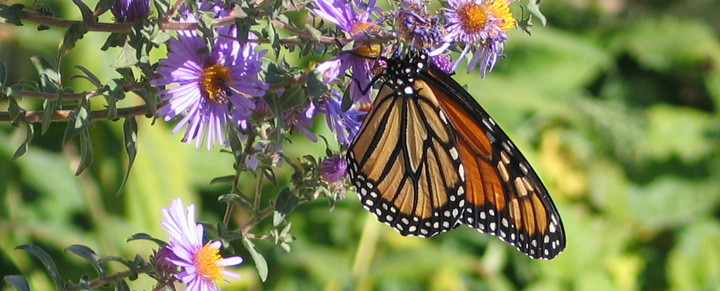

Purple Asters Were the Attraction in Our Butterfly Garden and on the Prairie
October 4--Five monarchs were observed in our butterfly garden during the day, and they ended up nectaring on purple asters in the back part of the garden.
October 5--A single monarch flew through our garden in the late morning.
October 6--One monarch was observed in the front garden in the early afternoon. The weather has continued to be warm in the 70s, and the wind has been stronger during the week with some gusts of more than 30 miles an hour.